Service Provider Routing and Switching, Professional (JNCIP-SP) v1.0
Question 1

You have the LDP signaled VPLS topology as shown in the exhibit. CE-B at Site-2 is multihomed to both PE-2 and PE-3.
In this scenario, where would you configure loop prevention?
- A. PE-1
- B. CE-B
- C. PE-3
- D. PE-2
Answer : A
Question 2
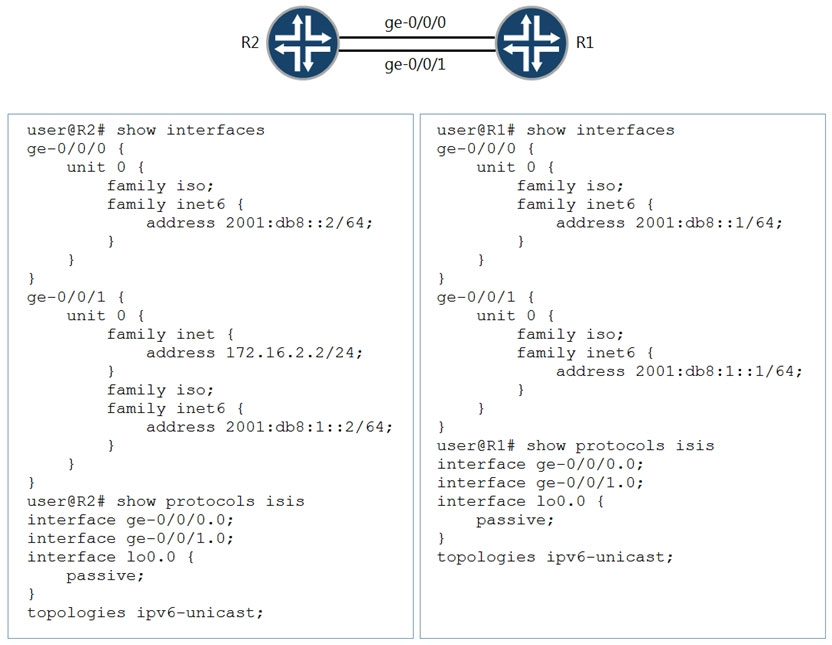
A network administrator is migrating from IPv4 to IPv6 and one of the IS-IS adjacencies is not coming up between R1 and R2.
Which action will solve the problem?
- A. Remove topologies ipv6-unicast from protocols isis on R2.
- B. Configure topologies ipv4-unicast from protocols isis on R2.
- C. Remove topologies ipv6-unicast from protocols isis on R1.
- D. Configure an IPv4 address on interface ge-0/0/1 on R1.
Answer : D
Question 3
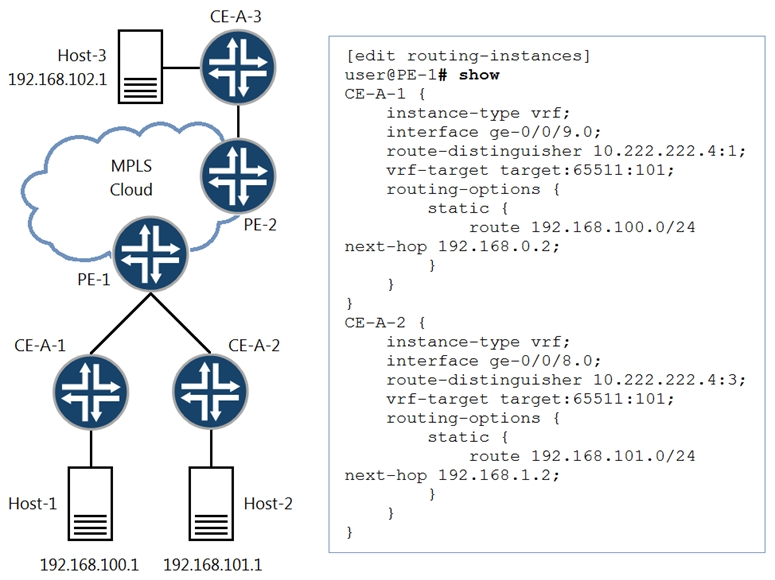
Referring to the exhibit, there is a Layer 3 VPN setup that connects sites CE-A-1, CE-A-2, and CE-A-3 together. Host-1 can communicate with Host-3, but Host-1 cannot communicate with Host-2.
What must you do to solve the problem?
- A. Change the route distinguisher in both routing instances to the same value.
- B. Use the next-table configuration statement for static routes in the corresponding routing instances.
- C. Use BGP instead of static routing between the CE and PE devices.
- D. Use the auto-export command in both routing instances.
Answer : D
Question 4
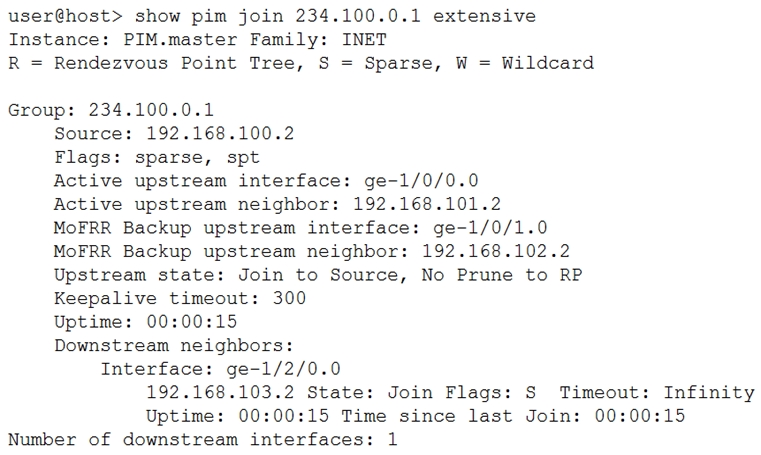
Which three statements are true about the show pim join output shown in the exhibit? (Choose three.)
- A. This is a source-specific multicast stream.
- B. The multicast receiver is still using the RP to receive the stream.
- C. The multicast stream has been configured with a backup path to allow for fast reroute.
- D. The multicast stream does not have an RP.
- E. The shortest path to the source is through the RP.
Answer : CDE
Question 5
Why do interprovider option B VPNs scale better than interprovider option A VPNs?
- A. The ASBRs in interprovider option B VPNs do not need per-VPN VRF tables.
- B. The ASBRs in interprovider option A VPNs do not need per-VPN VRF tables.
- C. The ASBRs in interprovider option A VPNs only carry internal routes.
- D. The ASBRs in interprovider option B VPNs only carry internal routes.
Answer : A
Question 6
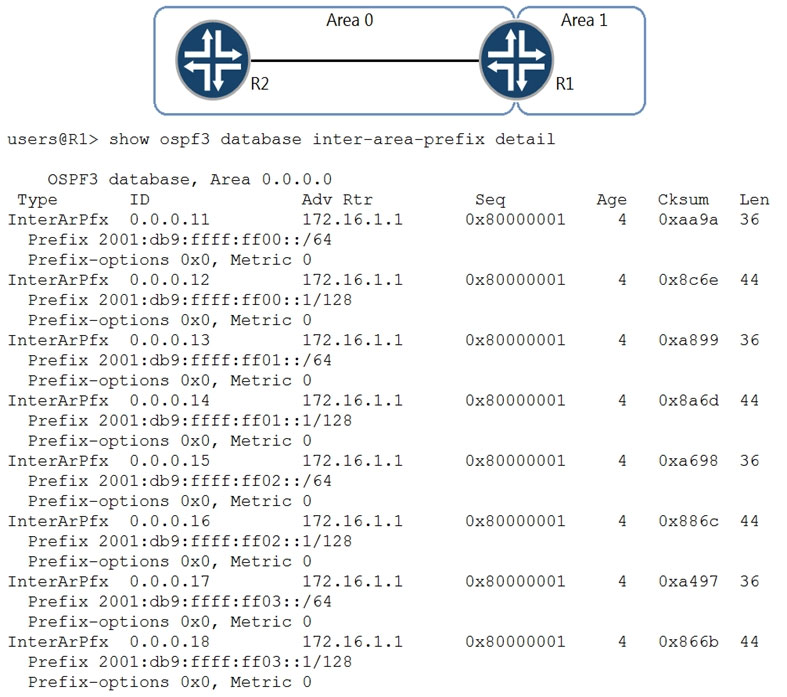
Referring to the exhibit, which command would reduce the size of the OSPF database and corresponding routes?
A.

B.

C.

D.

Answer : A
Question 7
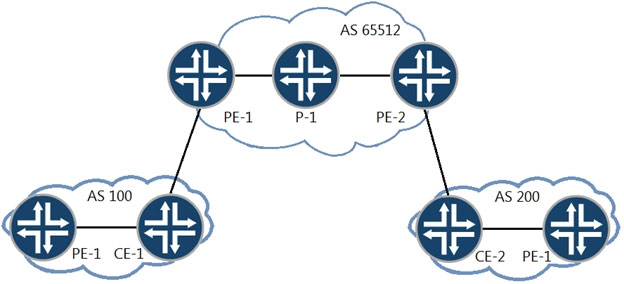
You are providing carrier-of-carrier VPN services for AS 100 and AS 200. You want to distribute MPLS labels between your PE routers and the AS 100 and AS
200 CE routers.
What must be enabled to accomplish this task?
- A. Use BGP with the inet-vpn address family enabled.
- B. Use BGP with the labeled-unicast address family enabled.
- C. Use RSVP with the lsp-set parameter enabled.
- D. Use RSVP with the tunnel-services parameter enabled.
Answer : A
Question 8
Which two statements regarding Ethernet segments (ES) are correct? (Choose two.)
- A. The Type-4 EVPN route will be used to elect the designated forwarder for the ES.
- B. The Type-3 EVPN route will be used for the aliasing function to load-balance to the ES.
- C. The Type-1 EVPN route will indicate if the ES is all-active or single-active.
- D. The Type-2 EVPN route will indicate if there is a designated forwarder on the ES.
Answer : AC
Question 9
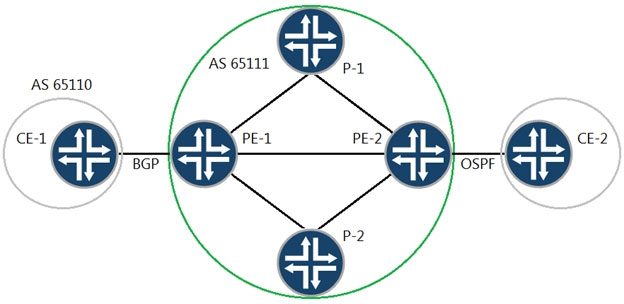
You have a Layer 3 VPN established between PE-1 and PE-2 to allow communication between CE-1 and CE-2.
Referring to the exhibit, which statement is correct?
- A. You will need an OSPF import policy on PE-1 to receive the BGP routes, learned from PE-2, through the Layer 3 VPN.
- B. You will need a BGP export policy on PE-1 to redistribute the routes, learned from CE-1, through the Layer 3 VPN.
- C. You will need a VRF import policy on PE-1 to advertise the BGP routes, learned from CE-1, through the Layer 3 VPN.
- D. You will need an OSPF export policy on PE-2 to redistribute the BGP routes, learned from PE-1, through the Layer 3 VPN.
Answer : D
Question 10
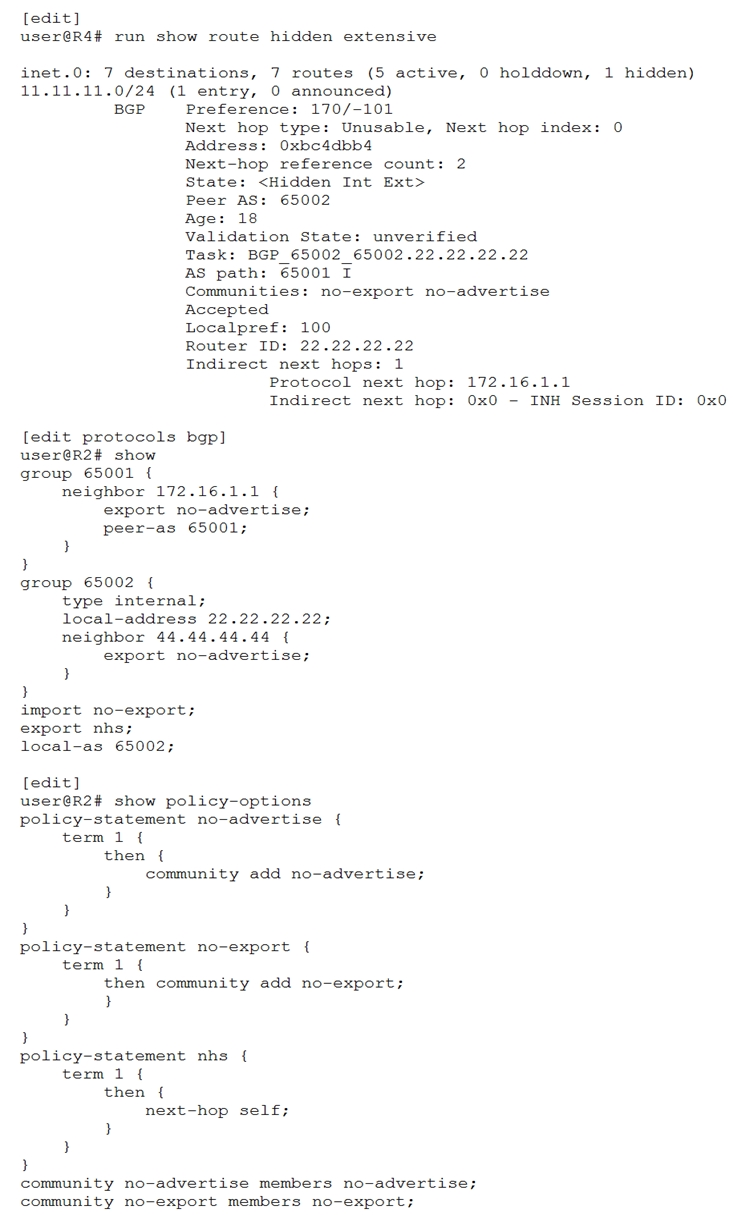
R2 is receiving a route from an EBGP neighbor and is advertising the route to R4.
Referring to the exhibit, which configuration on R2 will solve the issue with the route on R4?
- A. Move the no-advertise export policy from group 65002 to a global BGP policy.
- B. Move the nhs policy from a global BGP export policy to an export policy under group 65002.
- C. Move the no-export policy from a global BGP import policy to an import policy under group 65001.
- D. Move the no-advertise export policy from group 65001 to a global BGP policy.
Answer : B
Question 11
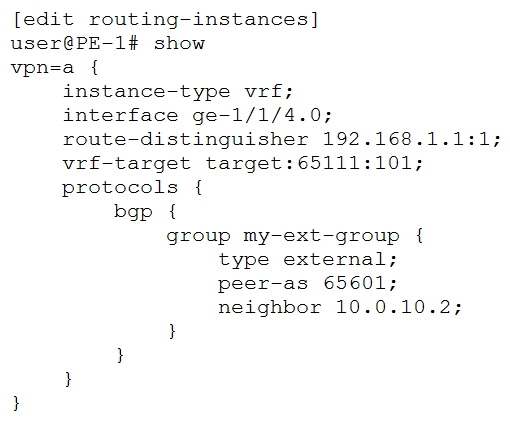
You have an established Layer 3 VPN between two PE devices. You are asked to only send certain routes from PE-1 over the VPN to the remote site while maintaining all the routes on the PE-1 device. You created a policy that matches the specific routes and then tags these routes with the appropriate target community values.
In this scenario, which configuration changes must be made to satisfy the requirement?
- A. Configure the export parameter and apply the policy to the my-ext-group BGP group configuration.
- B. Configure the vrf-export parameter and apply the policy under the edit routing-instances vpn-a hierarchy.
- C. Configure a RIB group and apply the policy as an import policy to routes distributed into the bgp.13vpn.0 routing table.
- D. Configure the import parameter and apply the policy to the my-ext-group BGP group configuration.
Answer : B
Question 12
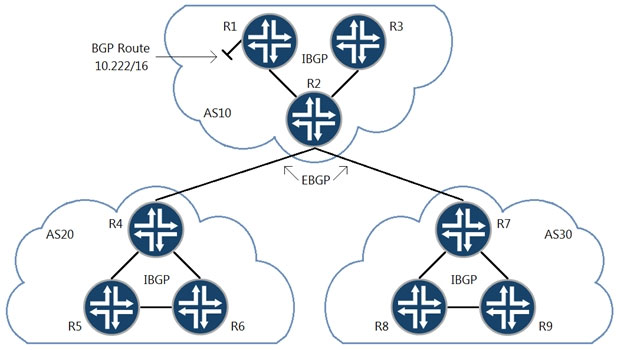
Referring to the exhibit, which three statements about route 10.222/16 are correct when using the default BGP advertisement rules? (Choose three)
- A. R1 will prepend AS10 when advertising 10.222/16 to R2.
- B. R2 will prepend AS10 when advertising 10.222/16 to R7.
- C. R2 will advertise 10.222/16 to R4 with itself as the next hop.
- D. R1 will advertise 10.222/16 to R2 with itself as the next hop.
- E. R7 will advertise 10.222/16 to R9 with itself as the next hop.
Answer : BCE
Question 13
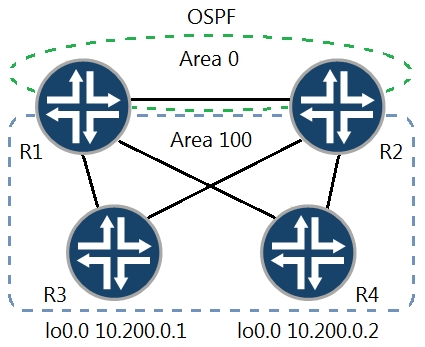
Traffic is being sent from R2 to R3. The link between R2 and R3 fails.
Referring to the exhibit, which statement is correct?
- A. Traffic will automatically reroute using the shortest path, which is R2 to R1 to R3.
- B. Traffic will automatically reroute distributed between all available paths.
- C. Manual intervention is required for traffic to be rerouted.
- D. Traffic will automatically reroute using R2 to R4 to R1 to R3.
Answer : D
Question 14

R1 assigns incoming voice traffic to the ef forwarding class. All other traffic is assigned to the best-effort forwarding class. You have configured a CoS re-write rule on R1 to include the correct CoS bit values in packets sent towards R2. You want R2 to classify traffic using the CoS markings created by R1.
Which two configuration steps are necessary to accomplish this task? (Choose two.)
- A. Assign the behavior aggregate classifier to the ge-0/0/1.0 interface on R2.
- B. Assign the CoS re-write rule to the ge-0/0/1.0 interface on R2.
- C. Configure a CoS re-write rule on R2 and assign matching CoS values.
- D. Configure a behavior aggregate classifier on R2.
Answer : AB
Question 15
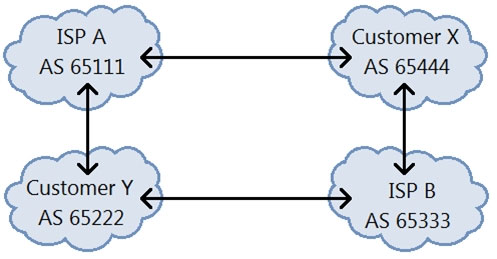
All networks shown in the exhibit contain more than one BGP speaker. You operate ISP A and must ensure that Customer Y sends their traffic to you over the directly connected link. Customer Y is not to be used for transit into your network.
What would you do to accomplish this task?
- A. Advertise routes to Customer X with the custom defined 0:0 community.
- B. Advertise routes to Customer X with the well-known no-advertise community.
- C. Advertise routes to Customer Y with the custom defined 65535:65535 community.
- D. Advertise routes to Customer Y with the well-known no-export community.
Answer : D